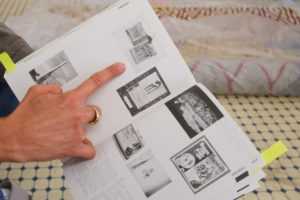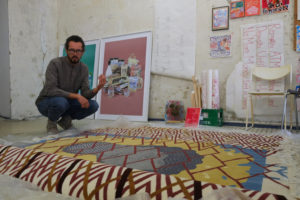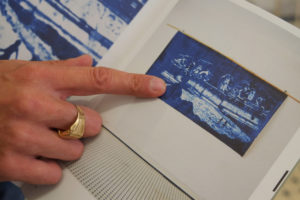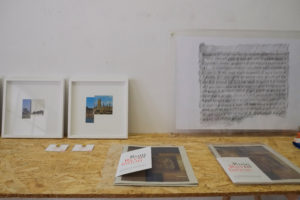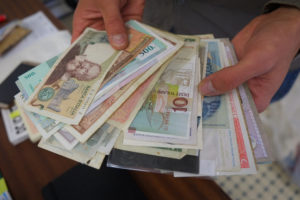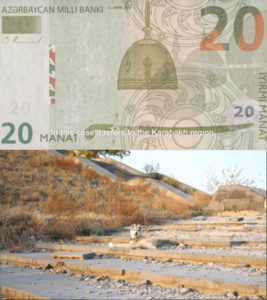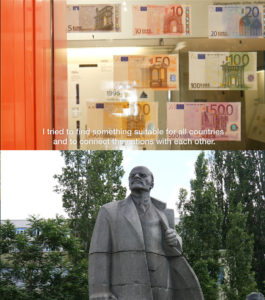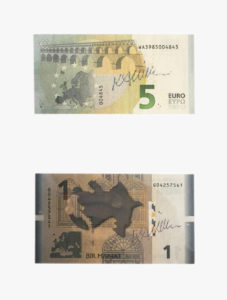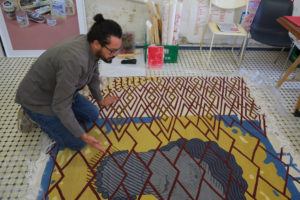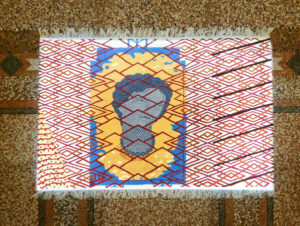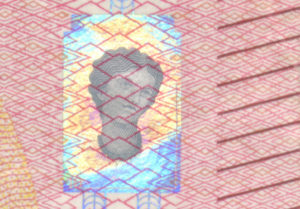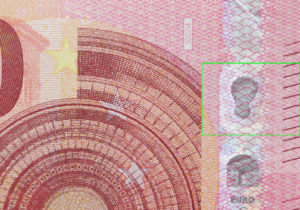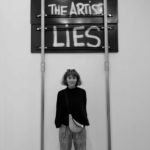MAGAZINE
Ryts Monet about "Der Euro des Kaukasus and Portrait of Europa" art works.
Chinara:
Hello! Can you introduce yourself, please? How did you arrive at your artistic name Ryts Monet?
Ryts Monet:
Hi, my full name is Enricomaria De Napoli. I am an Italian artist who has been based in Vienna for the last five years. I have this weird artistic name because I arrived at art through graffiti. I did illegal graffiti on trains and walls. When you are a graffiti artist, you must hide your identity by using a fake name in order to avoid being caught by the police. I was a traditional graffiti writer, so I liked writing my name in different ways. I chose the letters that I preferred, R Y T S.
When I was 13 or 14 years old, I started doing graffiti in my hometown, Lignano Sabbiadoro, which is a small city between Venice and Trieste, in the northeast of Italy. There were a lot of people doing graffiti at the same time, but after a few years, almost everyone stopped or they moved out of Lignano Sabbiadoro. I continued to do graffiti, but I was afraid of being caught. Later, I decided to change my style and name to “Monet” in order to mislead the police and convince them that I was someone else. If they had ever caught me with the name “Monet”, of course, I would have had problems, but not with the name RYTS, which was already spread everywhere. When I was 21, I moved to Venice to study visual art at the Iuav University of Venice and continued to do graffiti. Since I was in Venice, I decided there was no reason to keep one name or another. Every graffiti artist has one name, but nobody has a first name and a family name, so I kept both: Ryts Monet.
Chinara:
Can you expand on what your experience was like transitioning from being a graffiti artist to a contemporary artist?
Ryts Monet:
During my studies in Venice, I became more interested in other forms of art and started to visit exhibitions and museums. Lignano Sabbiadoro had no galleries, museums, nothing! The only things available to see were graffiti, music, skateboard, different types of subcultures. I switched my practice from graffiti to visual art, which led to what I’m currently doing. This process was slow, it took me a few years.
Chinara:
Okay. It’s really nice to hear your origin story.
How did you move from being a graffiti artist to an artist whose works require a lot of research before the production?
Ryts Monet :
There is a big separation between those practices, but what you can see in my artworks is that I still have some connection with the subcultures.
For me, the phase of research is very important because I don’t use any specific media. As you can see from my portfolio, I used collage, video, photography, carpets, or whatever because every artwork needs to be expressed through techniques or materials that are essential to the concept behind it.
Most of the time I start to work on a project because I get interested in something that I think is relevant for the time that we are living. Art must talk about our time. There is a German word that fits very well: Zeitgeist. It means “spirit of the time”. If you look at the history of art, the artists who made history were always deeply connected with their time. There is no significant art that was disconnected from the time it was created. Coming back to my works, in order to understand them, it’s necessary to go a little bit deeper because they have several “layers of meaning”. That’s why the research is necessary. If you want to go deeper into a specific topic, you need to do proper research.
In my artworks, I always try to establish a connection with the audience through what I call the “superficial layers,” which are usually visible at first glance. When people see my work, the first thing that comes to mind is how it was created or how it was displayed. In the second moment, something in their minds could switch. They get closer to the work as they become more interested in it, and they discover more layers of meaning.
Chinara:
Let’s keep talking about your art. I would like to start with Der Euro des Kaukasus (The Euro of the Caucasus) video installation and “Portrait of Europe” carpet installation because both of them have connections to banknotes and also Azerbaijan, where I am originally from. How did you come up with the ideas for these works?
RYTS MONET:
“The Euro of the Caucasus” started in 2019 with a personal meeting that I had with Robert Kalina, designer of Euro, who is Viennese and works for the Austrian National Bank. When I realized that the designer of the Euro it’s based here in Vienna, I decided to meet him. I found his contact and sent him an email introducing myself and asking if it would be possible to meet for an informal talk in a coffee bar, that’s how we started our conversations.
The main idea behind the design of the Euro was to create a new currency in order to connect the identities and the economies of a group of different nations. Briefly, European citizens needed to feel identified in the new currency, without having the feeling of being in a specific place/nation. Kalina has achieved this by creating architectural models that are similar to existing ones but do not in fact exist. The most interesting part for me is the fact that in order to build the sense of identification for all people in the European Union, Kalina decided to create something that is not real in the banknotes.
Der Euro des Kaukasus (The Euro of the Caucasus) is a two-channel video installation created in 2019 and presented at the end of a residency in Baku, in Azerbaijan, at the YARAT Contemporary Art Space, promoted by Cittadellarte – Fondazione Pistoletto in Biella.
In the same period, I applied for a residency in Azerbaijan, without having a precise idea about what I would do there. The intention was to develop research about the monuments, symbols and architecture between the Soviet and post-Soviet periods. When I went to Azerbaijan and saw the Manat (National Azerbaijani currency), my first impression was that it was really similar to the Euro.
Then I discovered that Robert Kalina also designed banknotes for Azerbaijan, an incredible coincidence! But the similarity between Euro and Manat was not a coincidence. It had been a special request from the Azerbaijan Central Bank to involve Robert Kalina as a designer for the new Manat and minted the banknote here (in Vienna) at the Austrian National Bank.
I found a bridge connecting Vienna, Baku, and my interests just a few days after arriving in Baku. Then I thought, well, I need to work on it!
I came back to Vienna and I met Kalina to film an interview with him. For Der Euro des Kaukasus (The Euro of the Caucasus) I decided to use only the sound of his voice during the interview and to overlay it with film footage that I made at the Geldmuseum in Vienna (part of the Austrian National Bank) and close-up details of the banknotes he designed.
I imagined the work in the form of a video projection. The architectural structures designed on the Euros, projected in a big scale, could appear as real architecture, not only drawings.
In the prior years, I also took videos of the socialist monuments and abandoned architecture in different countries of the former Soviet Union, including Hungary, Bulgaria and then once I was in Baku, I filmed also in Georgia and Azerbaijan. I edited these videos in sequences and I compared them with the architectures depicted on the Euros.
On one hand, you have these buildings depicted on the Euro that are “utopian architectures”, existing only on banknotes that refer to a group of European countries.
On the other hand, you have abandoned architecture from the former Soviet Union, architecture which does not represent a specific country (like Bulgaria or Azerbaijan) but different nations connected with the other socialist countries.
When I filmed those architectures and monuments in the former Soviet Union countries I saw many stray cats and dogs that have been included in the videos, I thought it was a very poetic thing. In one sequence, for example, you can see a statue of Lenin with the cats that are playing on his feet. Animals don’t care about ideologies and values, they just enjoy being there. But they are stray animals, which means they are abandoned and don’t have homes. In the video, I tried to connect all of these aspects together.
Chinara :
Can you talk about the mediums that you choose to use? You told me before that you like to work with different media. Can you tell me why you choose carpet as a medium for the “Portrait of Europe” work?
Ryts Monet:
The face of Europa is the only picture that represents a “human being” on the Euro banknotes. Take for example the ten Euro banknote, if you look at it, there is mainly architecture, a map of Europe, textures and numbers. But if you look at it against the light, in the watermark or on the silver hologram, it shows the portrait of Europe. The European Central Bank decided to include a reference to the myth of Europe and for me it’s another phenomenon. The myth of Europa refers to a mythological young lady that comes from the Middle East.
When I was working on the video “Der Euro Des Kaukasus,” I looked closely at the Euro banknotes. I was very fascinated by the arabesque pattern depicted on them that is reminiscent of the texture of a traditional Middle Eastern carpet. I thought it would be possible to develop these elements in one unique artwork that can connect Azerbaijan (and the Middle East) with Europe.
Then I contacted a company that produces handmade carpets in Baku and I asked them to reproduce on a carpet a scan of a 1 x 2 centimeter detail of a ten Euro banknote.
The detail included the portrait of Europa depicted on the silver hologram of the Euro banknotes. In the long process necessary for the production of the carpet, the workers have physically created the face of the myth of Europa.
Every single element of “Portrait of Europe” from the image resulting to the production process is connected with the meaning of value.
Chinara:
Thank you for the interview.
More details about the Der Euro des Kaukasus and Portrait of Europa:
https://rytsmonet.eu/Der-Euro-des-Kaukasus-and-Portrait-of-Europa
